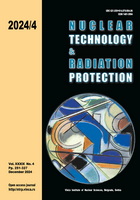
ASSESSMENT OF RADON EXHALATION RATE AND RADIUM CONTENT IN SOIL SAMPLES FROM EAST WEST BANK, PALESTINE

Vol.
XXXIX, No. 4, Pp. 251-327
December 2024
UDC 621.039+614.876:504.06
ISSN 1451-3994
Pages: 300-311
Authors: Walid M. Khalilia, Lilia A. Mashal, Alyda R. Faugno, Khalil M. Thabayneh, and Amal al-WahishAbstract
The study focused on measuring and calculating radiological characteristics related to radon concentration, radium content, radon exhalation rates, and radiation exposure in soil samples collected from various sites in the eastern West Bank, Palestine. The findings revealed notable variations in radon (222Rn) concentration across the study samples, ranging from 169.3 Bqm-3 in west Jericho city to 6184.4 Bqm-3 in Al-Maghtas, with a total average of 1705 Bqm-3. Similarly, effective radium content values varied significantly, ranging from 8.2-301.2 Bqkg-1, with a total average of 74 Bqkg-1. The average radon exhalation rates also exhibited considerable variability, ranging from 73.2 mBqm-2h-1 (3.1 mBqkg-1h-1) to 1419.8 mBqm-2h-1 (54.7 mBqkg-1h-1), with an average rate of 543 mBqm–2h-1 (19.5 mBqkg-1h-1). These results were compared to similar studies, where similarities and differences were noted. Based on concentration data and observed correlations, certain areas from which the samples were collected appear to pose significant health risk to residents. Consequently, these findings are significant and can be used as a reference for monitoring changes in radiation levels within the Jericho environment over time.
Key words: radon exhalation rate, radium content, CR-39 detector, sealed-can technique, cancer, Jericho
FULL PAPER IN PDF FORMAT (1,18 MB)